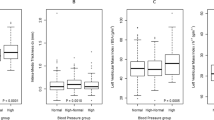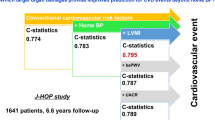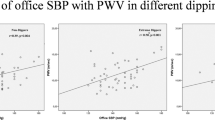Abstract
The relationship between ambulatory blood pressure (ABP), target organ damage (TOD) and aortic root (AR) size in human hypertension has not been fully explored to date. We investigated the relationship between ABP, different markers of TOD and AR size in never-treated essential hypertensive patients. A total of 519 grade 1 and 2 hypertensive patients (mean age 46±12 years) referred for the first time to our outpatient clinic underwent the following procedures: (1) routine examination, (2) 24 h urine collection for microalbuminuria (MA), (3) ambulatory blood pressure monitoring over two 24 h periods within 4 weeks, (4) echocardiography and (5) carotid ultrasonography. AR dilatation was defined by sex-specific criteria (⩾40 mm in men and ⩾37 mm in women). AR diameter was increased in 3.7% of patients. Demographic variables (body mass index, age and male gender), average night-time diastolic blood pressure (BP) (but not clinic or average 48 h BP), left ventricular mass index and carotid intima-media (IM) thickness showed an independent association with AR size in both univariate and multivariate analyses. When TOD data were analysed in a categorical way, a stepwise increase in the prevalence of left ventricular hypertrophy (LVH) (I=17.5%, II=27.6%, III=35.8%) and carotid IM thickening (I=20.9%, II=28.8%, III=34.4%), but not in MA (I=6.8%, II=9.1%, III=8.7%) was found with the progression of AR size tertiles. Our results show that (1) AR enlargement in uncomplicated never-treated hypertensive patients has a markedly lower prevalence than traditional markers of cardiac and extracardiac TOD; (2) night-time BP, LVH and carotid IM thickening are independent predictors of AR dimension.
This is a preview of subscription content, access via your institution
Access options
Subscribe to this journal
Receive 12 digital issues and online access to articles
$119.00 per year
only $9.92 per issue
Buy this article
- Purchase on Springer Link
- Instant access to full article PDF
Prices may be subject to local taxes which are calculated during checkout

Similar content being viewed by others
References
Seder JD, Burke JF, Pauletto FJ . Prevalence of aortic regurgitation by color flow Doppler in relation to aortic root size. J Am Soc Echocardiogr 1990; 3: 316–319.
Roman MJ, Devereux RB, Kramer-Fox R, O'Loughlin J . Two-dimensional echocardiographic aortic root dimensions in normal children and adults. Am J Cardiol 1989; 64: 507–512.
Isselbacker EM, Eagle KA, Sesanctis RW . Diseases of aorta.In: Braunwald E (ed.). Heart Disease: A Textbook of Cardiovascular Medicine. WB Saunders: Philadelphia, PA, 1997, pp 1546–1581.
Rayner BL, Goodman H, Opie LH . The chest radiograph, a useful investigation in the evaluation of hypertensive patients. Am J Hypertens 2004; 17: 507–510.
Kim M, Roman MJ, Cavallini MC, Schwartz JE, Pickering TG, Devereux RB . Effect of hypertension on aortic root size and prevalence of aortic regurgitation. Hypertension 1996; 28: 47–52.
Iarussi D, Caruso A, Galderisi M, Covino FE, Dialetto G, Bossone E et al. Associations of left ventricular hypertrophy and aortic dilation in patients with acute thoracic aortic dissection. Angiology 2001; 52: 447–455.
Palmieri V, Bella JN, Arnett DK, Roman MJ, Oberman A, Kitzman DW et al. Aortic root dilatation at sinuses of valsalva and aortic regurgitation in hypertensive and normotensive subjects. The hypertension genetic epidemiology network study. Hypertension 2001; 37: 1229–1235.
Pearson AC, Gudipati C, Nagelhout D, Sear J, Cone JD, Labovitz AJ . Echocardiographic evaluation of cardiac structure and function in elderly subjects with isolated systolic hypertension. J Am Coll Cardiol 1991; 17: 422–430.
Reed CM, Richey PA, Pulliam DA, Somes GW, Alpert BS . Aortic dimensions in tall men and women. Am J Cardiol 1993; 71: 608–610.
Vasan RS, Larson MG, Levy D . Determinants of echocardiographic aortic root size. Circulation 1995; 91: 734–740.
Tell GS, Rutan GH, Kronmal RA, Bild DE, Polak JF, Wong ND et al. Correlates of blood pressure in community-dwelling older adults. Hypertension 1994; 23: 59–67.
Cuspidi C, Meani S, Fusi V, Valerio C, Sala C, Zanchetti A . Prevalence and correlates of aortic root dilatation in patients with essential hypertension: relationship with cardiac and extracardiac target organ damage. J Hypertens 2006; 24: 573–580.
Fagard RH, Staessen JA, Thjis L . Prediction of cardiac structure and function by repeated clinic and ambulatory blood pressure. Hypertension 1997; 29: 22–29.
Zanchetti A, Bond MG, Hennig M, Neiss A, Mancia G, Dal Palu' C et al. Risk factors associated with alterations in carotid intima-media thickness in hypertension: baseline data from the European Lacidipine Study on Atherosclerosis. J Hypertens 1998; 116: 949–961.
Mancia G, Sega R, Bravi C, De Vito G, Valagussa F, Cesana G et al. Ambulatory blood pressure normality: results from the PAMELA study. J Hypertens 1995; 13: 1377–1390.
Verdecchia P, Schillaci G, Guerrieri M, Gatteschi C, Benemio G, Boldrini F et al. Circadian blood pressure changes and left ventricular hypertrophy in essential hypertension. Circulation 1990; 81: 528–536.
Sahn DJ, DeMaria A, Kisslo J, Weyman A . Recommendations regarding quantitation in M-mode echocardiography: results of a survey of echocardiographic measurements. Circulation 1978; 58: 1076–1083.
Devereux RB, Reickek N . Echocardiographic determination of left ventricular mass in man. Anatomic validation of the method. Circulation 1977; 55: 613–618.
de Simone G, Devereux RB, Daniels SR, Koren MJ, Meyer RA, Laragh JH . Effect of growth on variability of left ventricular mass; assessment of allometric signals in adults and children and their capacity to predict cardiovascular risk. J Am Coll Cardiol 1995; 25: 1056–1062.
Ganau A, Devereux RB, Roman MJ, de Simone G, Pickering TG, Saba TG et al. Patterns of left ventricular geometry and geometric remodelling in essential hypertension. J Am Coll Cardiol 1992; 19: 1550–1558.
Pignoli P, Tremoli E, Poli A, Paoletti R . Intimal plus medial thickness of the arterial wall: a direct measurement with ultrasound imaging. Circulation 1986; 74: 1399–1408.
Salonen R, Haapanen A, Salonen JT . Measurement of intima-media thickness of common carotid arteries with high-resolution B-mode ultrasonography: inter and intra observer variability. Ultrasound Med Biol 1991; 17: 225–230.
Guidelines Committee. European Society of Hypertension-European Society of Cardiology guidelines for the management of arterial hypertension. J Hypertens 2003; 21: 1011–1053.
Hodis HN, Mack WJ, LaBree L, Selzer RH, Liu C, Liu C et al. The role of carotid intima-media thickness in predicting clinical coronary events. Ann Intern Med 1998; 128: 262–269.
Executive Summary. The Third Report of the National Cholesterol Education Program (NCEP) Expert Panel on Detection, Evaluation and Treatment of High Blood Cholesterol in adult (Adult Treatment Panel III). JAMA 2001; 285: 2486–2497.
Joint National Committee on Prevention, Detection, Evaluation and Treatment of High Blood Pressure. The JNC 7 Report. JAMA 2003; 289: 2560–2572.
Bella JN, Wachtell K, Boman K, Palmieri V, Papademetriou V, Gerdts E et al. Relation of left ventricular geometry and function to aortic root dilatation in patients with systemic hypertension and left ventricular hypertrophy (The LIFE Study). Am J Cardiol 2002; 89: 337–341.
Staessen JA, Thijs L, Fagard R, O' Brien ET, Clement D, de Leeuw PW et al. Predicting cardiovascular risk using conventional versus ambulatory blood pressure in older patients with systolic hypertension. Systolic hypertension in Europe trial investigators. JAMA 1999; 282: 539–546.
Ohkubo T, Iami Y, Tsuji I, Nagai K, Watanabe N, Minami N et al. Relation between nocturnal decline in blood pressure and mortality: the Ohasama Study. Am J Hypertens 1997; 10: 1201–1207.
Sega R, Facchetti R, Bombelli M, Cesana G, Corrao G, Grassi G et al. Prognostic value of ambulatory and home blood pressures compared with office blood pressure in the general population. Circulation 2005; 111: 1777–1783.
Cuspidi C, Meani S, Salerno M, Valerio C, Fusi V, Severgnini B et al. Cardiovascular target organ damage in essential hypertensives with or without reproducible nocturnal fall in blood pressure. J Hypertens 2004; 22: 273–280.
Author information
Authors and Affiliations
Corresponding author
Rights and permissions
About this article
Cite this article
Cuspidi, C., Meani, S., Valerio, C. et al. Ambulatory blood pressure, target organ damage and aortic root size in never-treated essential hypertensive patients. J Hum Hypertens 21, 531–538 (2007). https://doi.org/10.1038/sj.jhh.1002200
Received:
Revised:
Accepted:
Published:
Issue Date:
DOI: https://doi.org/10.1038/sj.jhh.1002200
Keywords
This article is cited by
-
Pre-hypertension and subclinical carotid damage: a meta-analysis
Journal of Human Hypertension (2019)
-
Plasma C-terminal pro-endothelin-1 is associated with left ventricular mass index and aortic root diameter in African-American adults with hypertension
Journal of Human Hypertension (2011)
-
Sex-specific hemodynamic and non-hemodynamic determinants of aortic root size in hypertensive subjects with left ventricular hypertrophy
Hypertension Research (2009)



